Sensor Sweep: Otis Adelbert Kline, Clark Ashton Smith, Captain America
Monday , 3, February 2025 Sensor Sweep Leave a commentConan (The Take): When I was a teenager, my dad sat me down to watch one of the greatest fantasy films ever made: Conan the Barbarian, John Milius’ 1982 epic co-written by Oliver Stone, starring Arnold Schwarzenegger in the title role.
one of the greatest fantasy films ever made: Conan the Barbarian, John Milius’ 1982 epic co-written by Oliver Stone, starring Arnold Schwarzenegger in the title role.
D&D (Walker’s Retreat): The reason that TSR before 2000, and WOTC since, has gotten away with all their changes is because they were not only the sole source of the Network’s core product, but also the (for all intents and purposes) sole source of media regarding it.
Clark Ashton Smith (Sandpoint Reader): Of the many hazards of being an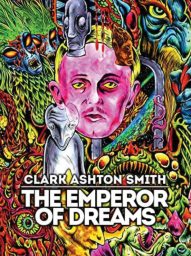 artistic trailblazer is that your creations turn into tropes while your hand in inventing them gets forgotten. That’s the fate suffered by Clark Ashton Smith, who has been credited as one of the greatest unsung romantic poets of the early 20th century.
artistic trailblazer is that your creations turn into tropes while your hand in inventing them gets forgotten. That’s the fate suffered by Clark Ashton Smith, who has been credited as one of the greatest unsung romantic poets of the early 20th century.
Cinema (Nerdrotic): “AMERICA F*CK NO!” Anthony Mackie Drops a MORONIC Take on Captain America
Robert E. Howard (Don Herron): It’s a photo I’ve never seen before. Regardless of whether or not it is known, it is an original of Howard’s father, apparently signed by the good doctor, as the signature does closely match other signatures of his I have seen.
Gaming (Kairos): Now let’s talk games, because unlike other institutions of culture, the games industry kept on growing and innovating for another 10 years. Then 2007 happened, and as far as the bigger publishers are concerned, games reached their peak and no more change or risk was required or even advisable. Gameplay seemed to stop changing almost entirely after 2007, and the extent to which it did change is usually in the negative.
Science Fiction (Vintage Pop Fictions): The 10th Victim is a 1965 science fiction novel by American writer Robert Sheckley (1928-2005). Bear with me because the story behind the novel is a bit complicated. In 1953 Sheckley wrote a short story, Seventh Victim, for Galaxy Science Fiction magazine.
fiction novel by American writer Robert Sheckley (1928-2005). Bear with me because the story behind the novel is a bit complicated. In 1953 Sheckley wrote a short story, Seventh Victim, for Galaxy Science Fiction magazine.
Review (Kit Sun Cheah): I don’t like Larry Correia’s Saga of the Forgotten Warrior. I realise this is an unpopular opinion to hold. This has nothing to do with the author’s politics. It has nothing to do with his personality either. And it is only tangentially related to him picking social media fights with everyone in my circles whenever he publishes a new book. My reaction to his series is based on a more fundamental reason: It is forgettable.
Sherlock Holmes (Comics Radio): My wife got me an awesome Sherlock Holmes desk calender for Christmas. (I got her a Chicago Cubs desk calendar, thus proving myself to be a husband of impeccable taste matching Angela’s impeccable taste. Gee whiz, we’re made for each other.)
Tolkien (Goodman Games): John Ronald Reuel Tolkien was born on January 3, 1892, in what is now South Africa. His parents, both English, had re-located so his father could accept a promotion with his current employer, a bank. He returned to England at the age of three, but his father succumbed to fever and never made the journey.
3, 1892, in what is now South Africa. His parents, both English, had re-located so his father could accept a promotion with his current employer, a bank. He returned to England at the age of three, but his father succumbed to fever and never made the journey.
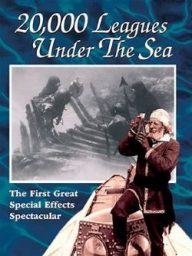 Cinema (Balladeer’s Blog): 20,000 LEAGUES UNDER THE SEA (1916) – The famous first cinematic adaptation of the Jules Verne classic. Having loved the version of this pioneering 1916 film that was available during the 1990s and earlier I had put off watching the restored and upgraded version released in 2010.
Cinema (Balladeer’s Blog): 20,000 LEAGUES UNDER THE SEA (1916) – The famous first cinematic adaptation of the Jules Verne classic. Having loved the version of this pioneering 1916 film that was available during the 1990s and earlier I had put off watching the restored and upgraded version released in 2010.
Cinema (Lotus Eaters): Sinking Our Teeth Into Robert Eggers’ Nosferatu
Arthur Conan Doyle (Dark Worlds Quarterly): The Best Science Fiction of Arthur Conan Doyle was edited by Charles G. Waugh and Martin Greenberg in 1981. Here are their picks for ACD’s best. I have not presented them in the order they appeared in the book but more chronologically by publication.
Fantasy (Sprague de Camp Fan): I first became aware of Michael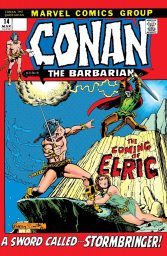 Moorcock and Elric by way of the Marvel Conan the Barbarian comic book. That two issue crossover featuring Conan and Elric was magnificent. I immediately purchased the two Elric volumes that were on sale at the J. L. Hudson’s store in Downtown Detroit. The Dreaming City and The Sleeping Sorceress.
Moorcock and Elric by way of the Marvel Conan the Barbarian comic book. That two issue crossover featuring Conan and Elric was magnificent. I immediately purchased the two Elric volumes that were on sale at the J. L. Hudson’s store in Downtown Detroit. The Dreaming City and The Sleeping Sorceress.
Edgar Rice Burroughs (Black Gate): For sheer fun and adventure there’s nothing better in my opinion than Sword & Planet fiction (also called Interplanetary Adventure, Interplanetary Romance, or Planetary Romance). But exactly what is Sword & Planet fiction? Well, Edgar Rice Burroughs (ERB) created the prototype in 1911 with A Princess of Mars, which featured an Earthman named John Carter who is mysteriously transported to Mars, called Barsoom by its inhabitants.
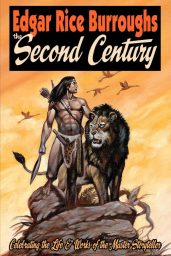
Edgar Rice Burroughs (Pulp Super-Fan): I discovered an interesting book on Edgar Rice Burroughs (1875-1950) and his works that was produced by the National Capital Panthans, a Washington, D.C., area group of the Burroughs Bibliophiles. It’s one of the largest such local groups, with a monthly meeting (now via Zoom) and a monthly journal. Edgar Rice Burroughs: The Second Century has the subtitle of “Celebrating the Life & Works of the Master Storyteller.”
Fiction (Paperback Warrior): It is that admiration for the genre that prompted him to author a pulpy sword-and-sorcery series titled Snakehaven. As of this writing there are three installments – Doom of the Dark Delta, Fear on the Fever Coast, and Lair of the Serpent Queen. These are one-buck ebooks that weigh in at one-hundred pages give or take a font size.
prompted him to author a pulpy sword-and-sorcery series titled Snakehaven. As of this writing there are three installments – Doom of the Dark Delta, Fear on the Fever Coast, and Lair of the Serpent Queen. These are one-buck ebooks that weigh in at one-hundred pages give or take a font size.
The Matrix (Reading Experience): Litblogs still exist, but many of the blogs that initially brought attention to the phenomenon of litblogging do not, or have been modified into more general literary websites. At first, litblogs were pretty closely tied to the established print media that devoted space to books coverage and other literary news.
 Clark Ashton Smith (Sprague de Camp Fan): I have been intrigued by Clark Ashton Smith since the time I bought the Ballantine Adult Fantasy copy of Zothique in 1970. I followed up and bought Hyperborea and Xiccarph and have been collecting Smith books all of my life. I had never read any of Smith’s non-fiction so when the Mirage Press came out with Planets and Dimensions: Collected Essays of Clark Ashton Smith in 1973 I bought a paperback and a hardcover!
Clark Ashton Smith (Sprague de Camp Fan): I have been intrigued by Clark Ashton Smith since the time I bought the Ballantine Adult Fantasy copy of Zothique in 1970. I followed up and bought Hyperborea and Xiccarph and have been collecting Smith books all of my life. I had never read any of Smith’s non-fiction so when the Mirage Press came out with Planets and Dimensions: Collected Essays of Clark Ashton Smith in 1973 I bought a paperback and a hardcover!
Ghost Stories (Old Style Tales): It was an era of easy unease and anxious indulgence, dominated by authors who embodied this shadowy, grimly comic blend of dark and light: J. M. Barrie, the Benson brothers, Ambrose Bierce, Algernon Blackwood, G. K. Chesterton, Arthur Conan Doyle, Joseph Conrad, E. M. Forster, Kenneth Grahame, William Hope Hodgson, W. W. Jacobs, M. R. James, Rudyard Kipling, Oliver Onions, Edith Nesbit, Saki, George Bernard Shaw, H. G. Wells, Edith Wharton, and P. G. Wodehouse.
Horror (Blasphemous Tomes): Building on last episode’s discussion of Lovecraftian horror and detective fiction explored in Heather Miller’s Ripples From Carcosa, we’re delving into another part of the book, which lays out the idea of haunted landscapes.
Artists (DMR Books): The English artist, Jim Pitts, turned seventy-five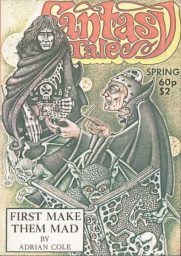 today. He can look back in pride on a long and creative career in the British fantasy/horror market.
today. He can look back in pride on a long and creative career in the British fantasy/horror market.
Jim was born in Blackburn, Lancashire in 1950, just south of the Scottish border. He studied at the Shadsworth secondary school and paid the bills by working at the local brewery. Then came his first break, as told in a 2017 interview:
Tolkien (Isegoria): Bakshi’s LOTR adaptation has a unique look, employing an animation style barely used in modern times — Rotoscoping. This was a technique used extensively in the early days of animation, with artists tracing over live-action footage. It worked wonderfully for this film, giving the characters dynamic energy and a sense of perpetual motion, but Bakshi went one step further.
New Pulp (Rough Edges): PULP ADVENTURES #46 is out, and it’s another fine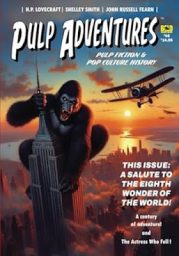 issue of this book/magazine from Bold Venture Press. More than half of this issue is devoted to the classic movie KING KONG, with a lengthy, in-depth examination by Bart Pierce of a long-time mystery: who played the woman Kong plucked out of her hotel room in the mistaken belief she was Ann Darrow (Fay Wray) and then callously threw her to her death when he realized she wasn’t?
issue of this book/magazine from Bold Venture Press. More than half of this issue is devoted to the classic movie KING KONG, with a lengthy, in-depth examination by Bart Pierce of a long-time mystery: who played the woman Kong plucked out of her hotel room in the mistaken belief she was Ann Darrow (Fay Wray) and then callously threw her to her death when he realized she wasn’t?
Robert E. Howard (Grognardia): Janus must be very fond of writers, for so many were born this month: J.R.R. Tolkien, Clark Ashton Smith, Edgar Allan Poe, Abraham Merritt and, today, Robert Ervin Howard. Of them all, Howard is possibly unique in having created a character – Conan – who is a genuine pop cultural icon.
Cinema (Kiramid Head): KiramidHead and Jake from Hot Quality Content discuss the draft of Dune that Ridley Scott was attached to direct.
Robert E. Howard (Goodman Games): There may not be a more iconic character in fantasy—and particularly sword and sorcery—fiction than Conan the Barbarian. From his first appearance in Weird Tales back in 1932, the character has influenced how we see any iconic sword-wielding hero. And for that, we can thank Robert E. Howard.
Authors (Silver Key): The news is out, and it is terrible though not unexpected. Howard Andrew Jones, author of The Desert of Souls, the Hanuvar chronicles, and former editor of Tales from the Magician’s Skull, passed away yesterday following a short battle with brain cancer.
Pulp (Rough Edges): Otis Adelbert Kline didn’t always look to Edgar Rice Burroughs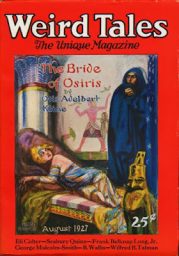 for his inspiration, although his short novel THE BRIDE OF OSIRIS (serialized in the August, September, and October 1927 issues of WEIRD TALES) does have a subterranean civilization in it.
for his inspiration, although his short novel THE BRIDE OF OSIRIS (serialized in the August, September, and October 1927 issues of WEIRD TALES) does have a subterranean civilization in it.
Fantasy (Scriblerus Club): “Ballantine Books clearly recognized this dichotomy. Not a major player in the Sword and Sorcery market, the firm was eager to strike out in a more Tolkien-specific direction. The initial results over the next few years were a bit halting and haphazard. The Hobbit followed The Lord of the Rings in 1965, and the remaining work by Tolkien then accessible was gathered in The Tolkien Reader (1966) and Smith of Wootton Major and Farmer Giles of Ham (1969).
Fiction (Grave Tapping): John Steinbeck wrote The Moon is Down, as an anti-Nazi propaganda piece for the U.S. Foreign Information Service (FIS)—which means it is one of Steinbeck’s minor works but it is far from lifeless propaganda and very much worth reading as literature.
Fiction and Firearms (Frontier Partisans): Scotland has adopted and adapted the plot into a sportsman’s challenge known as The MacNab: Catch a salmon on the fly, shoot a brace of grouse with the shotgun, and take a stag (surely with a John L. Rigby Highland Stalker, right?), between dawn and dusk of a single day. That’ll cure the ennui…
Radio (Escape-Suspense): The Suspense episode “The Hitchhiker” is well known because the radio play was transformed into a television episode, and it has since lived on in reruns. In this story, a supernatural hitchhiker follows the main character on a trip across the country.
Comic Books (Black Gate): Savage Sword of Conan, from Titan Comics, is the comic book that I have been waiting for. It is a thing of perfection: art, story, presentation, physical format – all unmatched. The cover by Joe Jusko is brilliant, capturing some brutal imagery from the prose story within, penned by Jim Zub. I loved Joe’s work on the original SSoC run.
Authors (Black Gate): That was my response to seeing John O’Neill’s post on Friday, announcing that Howard had lost his battle with brain cancer. Facebook has been full of fond memories and sorrows from his many friends.
Radio (Archive): The Witch’s Tale was a horror-fantasy radio series which aired from May 21, 1931, to June 13, 1938, on WOR, the Mutual Radio, and in syndication. The program was created, written, and directed by Alonzo Deen Cole (February 22, 1897, St. Paul, Minnesota – April 7, 1971).
Please give us your valuable comment